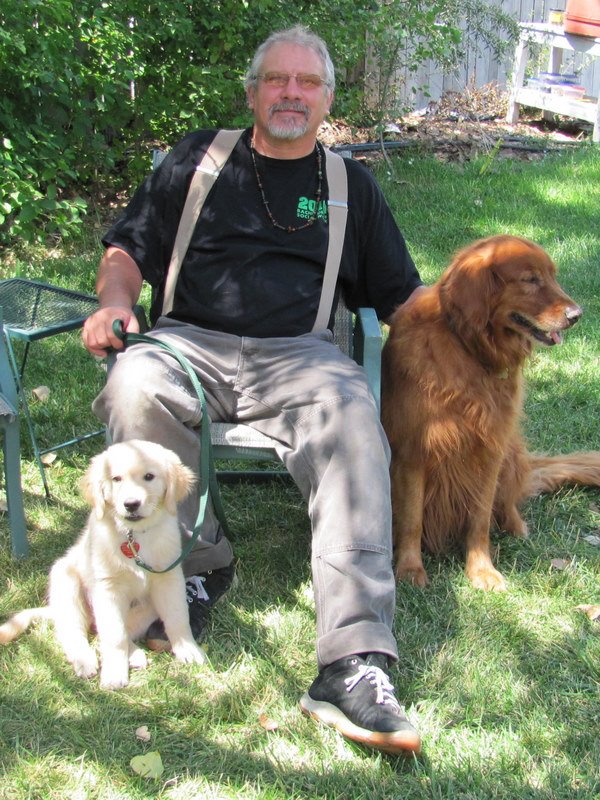
Lynda Bidlake: I started doing therapy dog work in 2000, in the schools of the Thompson district (and also in nursing homes). In 2003 my dog Ollie and I were certified as a team through Human-Animal Bond in Colorado (HABIC), a program started by Dr. Ben Granger, Director of the Social Work Department at CSU, and his wife Georgia. In addition to training, certification and support, the HABIC program provided insurance for our dog-human teams while we were working in the schools. (This is true for many therapy dog programs.)
The HABIC program was first designed to assist Special Education students on an individual basis. All our therapy dogs were trained to respond to many commands (Ollie knew over 30); the students learned to give (or teach) the commands to the dogs. Through collaboration between HABIC and teachers, a program was designed specifically for each student, often tied to their IEP goals. For example, if a student could remember a series of commands (tied to a short-term memory goal), the dog would do them – which provided immediate reinforcement to the child. The results were demonstrated by progress on the student’s goals. Some of the results seemed almost miraculous. For example, the very first word spoken by one little girl with cerebral palsy was “Ollie;” that child also greatly improved her range of motion and arm strength by throwing a ball to the dog.
We were becoming aware of the emotional support that a dog can provide. When I was working as a school psychologist, I was fortunate enough to be able to take Ollie for full days in my counseling room. (In the HABIC program, we often finished the school year by having the student give a presentation to their class of the commands and routines they and the dog could do – a real boost to the confidence of a Special Ed student. Other than that, our dogs were seldom in a large classroom. With highly empathic dogs like our Golden Retrievers, a full day in a classroom would be exhausting.) In my small counseling room, Ollie was often present during one-on-one sessions. Sometimes a child could tell a dog something they had been told not to tell a person. (I remember a 5-year-old sitting on the floor and solemnly asking Ollie, “Do they hit you at your house?” Uh-oh.) Later, in a middle school, I became aware of how a good dog can be a co-therapist; for example, Ollie could tell when a student was truly feeling an emotion vs. when it was “drama.” And, most of all, a dog is a source of emotional support. I couldn’t count the number of times Ollie’s coat got wet from a child’s tears. Teachers would come in for an “Ollie-fix” on hard days, too.
In 2009 we began to expand the therapy-dog program.  By that time we had added a second Golden, Honey, to our family and certified her and my husband as a therapy-dog team. My husband, Lewis BrightHeart Headrick, was working on his BSW and then his MSW at CSU. He had been aware of the work I had done on crisis-response teams for years, and he came up with the idea to combine that with the therapy-dog work. As a project for one of Dr. Granger’s classes, he and I created a program to train HABIC volunteers to bring their dogs to crisis responses in schools. This involved extensive training for the volunteers, setting up procedures and protocols, and coordinating with the district. Early in each crisis response, the principal and other district administrators would be asked whether they wanted dog(s) for that response (they almost always did, especially after they started hearing from other administrators who had experienced what our dogs could add). Based on that, we would plan how many dogs and where to station them in the school, call the teams in, rotate them after an hour, debrief the volunteers at the end of the day. The program was highly successful. Frequently our observation was that the presence of a dog or dogs helped us reach students who otherwise had isolated themselves in their grief. However, eventually we realized that it was a lot to ask of volunteers, even though they had been coached that their responsibility was solely to accompany their dog and that they should let the counselors be the counselors. After about three years, we changed the program to have our district mental health professionals bring their own dogs to the responses, after they had trained and certified them. I continued to coordinate these crisis-team responses in the Thompson district until 2017.
By that time we had added a second Golden, Honey, to our family and certified her and my husband as a therapy-dog team. My husband, Lewis BrightHeart Headrick, was working on his BSW and then his MSW at CSU. He had been aware of the work I had done on crisis-response teams for years, and he came up with the idea to combine that with the therapy-dog work. As a project for one of Dr. Granger’s classes, he and I created a program to train HABIC volunteers to bring their dogs to crisis responses in schools. This involved extensive training for the volunteers, setting up procedures and protocols, and coordinating with the district. Early in each crisis response, the principal and other district administrators would be asked whether they wanted dog(s) for that response (they almost always did, especially after they started hearing from other administrators who had experienced what our dogs could add). Based on that, we would plan how many dogs and where to station them in the school, call the teams in, rotate them after an hour, debrief the volunteers at the end of the day. The program was highly successful. Frequently our observation was that the presence of a dog or dogs helped us reach students who otherwise had isolated themselves in their grief. However, eventually we realized that it was a lot to ask of volunteers, even though they had been coached that their responsibility was solely to accompany their dog and that they should let the counselors be the counselors. After about three years, we changed the program to have our district mental health professionals bring their own dogs to the responses, after they had trained and certified them. I continued to coordinate these crisis-team responses in the Thompson district until 2017.
Many other school districts nationwide have used the resource of therapy dogs. I would like to be part of researching and planning how to provide this service to others. It’s some of the most rewarding work we have ever done.
